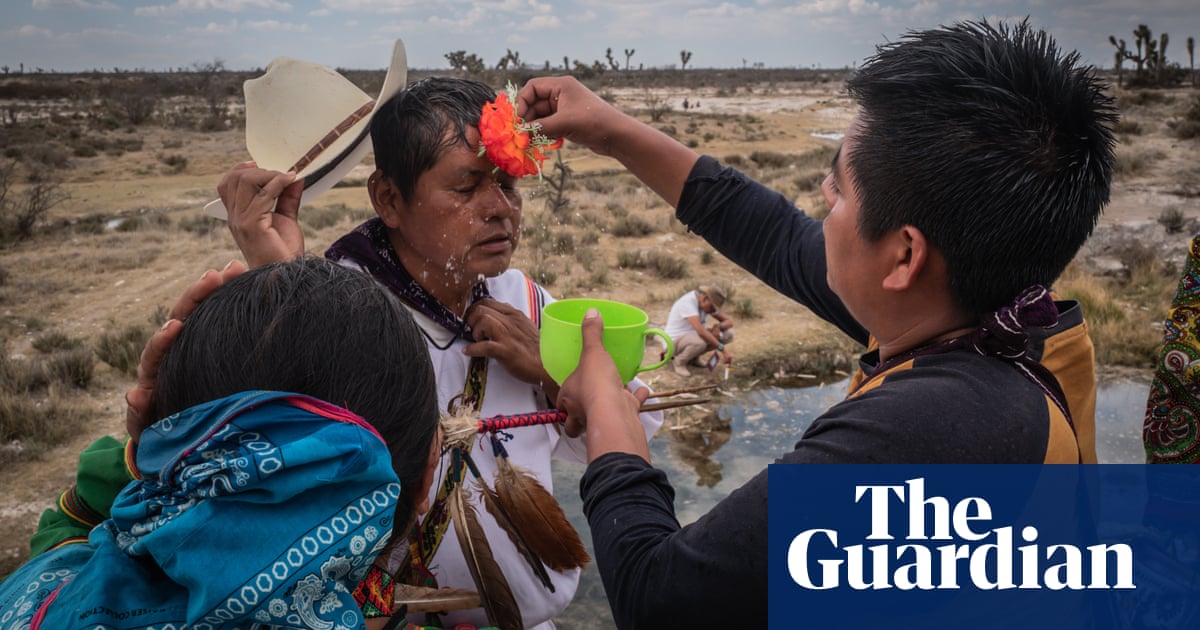
Every year, members of Mexico’s Indigenous Wixárika people make an arduous 800km (500-mile) pilgrimage from San Andrés Cohamiata in the highlands of Jalisco to the semi-arid desert of San Luis Potosí. Their destination is Wirikuta, a sacred gathering place where, according to their beliefs, the world was created from a drop of water.
Once gathered, the pilgrims await a special night on which peyote, a hallucinogenic cactus at the heart of the Wixárika people’s spiritual rituals, is blessed and distributed. But for the past five years a shadow has loomed over the ceremony: drought.
“There used to be a sort of peyote carpet here,” says Silviño, who runs a popular desert lodge. “Now, you have to look for them. With a little rain, hundreds could grow very quickly, but without rain they dry up before they even have the chance to grow.”
The lack of rain is not the only factor driving water scarcity in this desert region. First mining and now agribusiness threaten the desert’s springs, affect the weather and jeopardise residents’ right to water.
Known as the “guardians of peyote”, there are about 80,000 Wixárika – also called the Huichol. For this Aztecan-speaking ethnic group, water is a gift from the gods to which they attribute powers of purification, healing and fertility. Due to their isolation, they are one of the Indigenous communities in Mexico that have best preserved their traditions and beliefs, and the 140,000-hectare (346,000-acre) Wirikuta cultural and ecological reserve is considered their most sacred place.
The region was the scene of conflict in 2010 after the Mexican federal government awarded silver and gold-mining concessions – 70% of which overlapped the Wirikuta reserve, according to activists. A year later, the government granted further concessions, with 42% of the land earmarked for mining encroaching on the reserve’s area.
Indigenous defenders, environmentalists and NGOs, such as Culture Survival, fear that mining could lead to further water shortages and produce tailings that will contaminate the environment. Heavy metals such as cyanide, used to leach silver, often contaminate the soil around silver and goldmines, affecting groundwater and rivers with consequences for the region’s watershed.
To counter this threat the Wixárika mobilised to preserve surface and underground water sources in Wirikuta; Margarito Díaz, a marakame or shaman, was at the forefront of the action.
Alongside other desert communities, the Wixárika organised a protest march to the presidential palace in Mexico City in 2011; as a consequence, in September 2013, a judge ordered the suspension of all 78 mining concessions granted in the Wirikuta territory.
But success in this case and a series of positive outcomes on behalf of his people in other campaigns turned Díaz into a target. On the night of 8 September 2018, he was shot and killed. He was 59 years old.
“We knew that he was not making friends defending the water and the culture of our Indigenous people, but we never imagined that it could cost him his life,” says Arsenio Díaz, the eldest of the shaman’s six children.
Díaz’s name, along with those of the Wixárika leaders Vázquez and Agustín Torres, killed by drug traffickers in 2017, is on the list of 1,335 defenders across Latin America who lost their lives between 2012 and 2022, according to Global Witness. Indigenous people are disproportionately targeted, accounting for more than a third of the attacks, despite making up only 5% of the world’s population.
In July 2022, a suspect was arrested for Díaz’s murder and the investigation is still going on. However, Maximino Muñoz de la Cruz, president of the Human Rights Commission of Nayarit, is in no doubt that in a country where 93% of homicides go unpunished, whoever was behind the shooting is still free.
What is certain is that even after Díaz’s death – and despite his victories – Wirikuta land and water remain under threat.
Twenty years ago, the view from the back yard of a small home in La Pasadita was cactus growing as far as the eye could see. Now, the desert flora has been wiped out, replaced by huge farms growing just one thing: tomato plants.
Since the 2000s, agriculture has grown exponentially in the state of San Luis Potosí, helping to make Mexico the world’s leading exporter of tomatoes, while putting more pressure on its already scarce water resources. Several Mexican companies, attracted by cheap land and government support, settled in the Wixárika’s region.
San Luis Potosí has become the second-largest tomato-producing region in the country; about 2,000 hectares (5,000 acres) have been bought from desert dwellers to cultivate tomatoes. In Wirikuta alone, the land dedicated to tomato production has more than trebled since 2014, and now covers 170 hectares.
The temperature hovers at about 40C as Erica Villanueva Moncada, 31, breastfeeds her three-month-old baby in the tiny living room of her house: “I was five months pregnant the last time it rained,” she says. “I remember because here a rainy day is spoken of as if it was something extraordinary.”
Villanueva has 11 siblings and lives with her parents. To drink, bathe, wash clothes and irrigate their crops, the family has no choice but to buy water. A 10,000-litre tank costs about 700 pesos (£32), which lasts less than a month. They are worried about the corn and beans, which have been difficult to grow since the drought began in May 2022. The Villanuevas believe those responsible for the drought are the neighbours who sold their lands to the tomato growers.
“From here, you can hear their anti-hail rockets [shot into the sky to scatter storm clouds and prevent hailstones from damaging crops] and their agricultural planes, and you can see that the sky is tense as if it is going to rain. Then, after the planes pass, nothing falls,” says Erica’s mother, Mari, 58, describing the “anti-hail” technologies being wielded by the farms. The hail rockets, which research suggests may not even be effective, are blamed by many for disrupting rain as well as hail and causing drought.
But what worries the Villanueva family most is that the aquifers will eventually dry up. The irrigation of tomato crops in San Luis Potosí requires more than 4m cubic metres of water a year. Tomato growers have resorted to drilling new wells in the desert to irrigate their crops.
“This is a problem we are already seeing today, but that endangers the livelihoods of our children and grandchildren,” says Héctor Villanueva, Erica’s cousin. To put pressure on the authorities, he created the Comité del agua, a water committee dedicated to highlighting the situation.
In their struggle to defend natural resources, the desert communities have found allies in the Wixárika. Álvaro Ortiz, 50, known as “Puwari”, is among those continuing Díaz’s struggle. He is an artist whose designs are inspired by the Indigenous community.
For Puwari, the battle for water is the mother of all struggles: “Tatei haramara [Mother water] in the Wixárika cosmovision is our mother because we come from her, so it is important to take care of her and fight against everything that alters her natural course,” he says.
The Union of Ceremonial Centers of Jalisco, Durango and Nayarit, of which Díaz was secretary, has also joined the fight against what they see as a process of privatisation of the water and the desert by agribusiness.
In August 2023, after dozens of meetings with residents and Wixárika representatives, Mexican president Andrés Manuel López Obrador issued a decree “recognising, protecting, preserving and safeguarding” all the sacred places and sites of the Wixárika peoples and establishing a catalogue of these holy sites through the National Institute of Anthropology (INA) – a long-held dream for Díaz.
However, the enforcement of this decree is still unclear, as are the legal safeguards against the sale of land to companies. As a result, Puwari remains steadfast in his role as a resistance leader. “We will defend our collective natural assets to the end whatever happens,” he says.
In the desert, Suzana, 50, an experienced marakame and one of Díaz’s religious heirs, invokes the rain. Noelia, her seven-year-old niece, stands nearby. The little girl had a vision a year ago when she consumed peyote: one day, she too will be a marakame. The next generation of nature defenders is coming.











